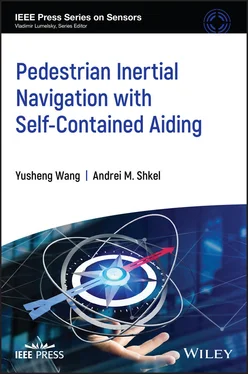1 Cover
2 Title Page Pedestrian Inertial Navigation with Self‐Contained Aiding Yusheng Wang and Andrei M. Shkel University of California, Irvine IEEE Press Series on Sensors Vladimir Lumelsky, Series Editor
3 Copyright Copyright © 2021 by The Institute of Electrical and Electronics Engineers, Inc. All rights reserved. Published by John Wiley & Sons, Inc., Hoboken, New Jersey. Published simultaneously in Canada. No part of this publication may be reproduced, stored in a retrieval system, or transmitted in any form or by any means, electronic, mechanical, photocopying, recording, scanning, or otherwise, except as permitted under Section 107 or 108 of the 1976 United States Copyright Act, without either the prior written permission of the Publisher, or authorization through payment of the appropriate per‐copy fee to the Copyright Clearance Center, Inc., 222 Rosewood Drive, Danvers, MA 01923, (978) 750‐8400, fax (978) 750‐4470, or on the web at www.copyright.com . Requests to the Publisher for permission should be addressed to the Permissions Department, John Wiley & Sons, Inc., 111 River Street, Hoboken, NJ 07030, (201) 748‐6011, fax (201) 748‐6008, or online at http://www.wiley.com/go/permission . Limit of Liability/Disclaimer of Warranty: While the publisher and author have used their best efforts in preparing this book, they make no representations or warranties with respect to the accuracy or completeness of the contents of this book and specifically disclaim any implied warranties of merchantability or fitness for a particular purpose. No warranty may be created or extended by sales representatives or written sales materials. The advice and strategies contained herein may not be suitable for your situation. You should consult with a professional where appropriate. Neither the publisher nor author shall be liable for any loss of profit or any other commercial damages, including but not limited to special, incidental, consequential, or other damages. For general information on our other products and services or for technical support, please contact our Customer Care Department within the United States at (800) 762‐2974, outside the United States at (317) 572‐3993 or fax (317) 572‐4002. Wiley also publishes its books in a variety of electronic formats. Some content that appears in print may not be available in electronic formats. For more information about Wiley products, visit our web site at www.wiley.com . Library of Congress Cataloging‐in‐Publication Data applied for: ISBN: 9781119699552 Cover Design: Wiley Cover Image: © Production Perig/Shutterstock
4 Author Biographies Author Biographies Yusheng Wang, PhD, received the B.Eng. degree (Hons.) in engineering mechanics from Tsinghua University, Beijing, China, in 2014 and the Ph.D. degree in mechanical and aerospace engineering from the University of California, Irvine, CA, in 2020. His research interests include the development of silicon‐based and fused quartz‐based MEMS resonators and gyroscopes, and pedestrian inertial navigation development with sensor fusion. He is currently working at SiTime Corporation as an MEMS Development Engineer. Andrei M. Shkel, PhD , has been on faculty at the University of California, Irvine since 2000, and served as a Program Manager in the Microsystems Technology Office of DARPA. His research interests are reflected in over 300 publications, 42 patents, and 3 books. Dr. Shkel has been on a number of editorial boards, including Editor of IEEE/ASME JMEMS, Journal of Gyroscopy and Navigation , and the founding chair of the IEEE Inertial Sensors . He was awarded the Office of the Secretary of Defense Medal for Exceptional Public Service in 2013, and the 2009 IEEE Sensors Council Technical Achievement Award. He is the President of the IEEE Sensors Council and the IEEE Fellow.
5 List of Figures
6 List of Tables
7 1 Introduction1.1 Navigation 1.2 Inertial Navigation 1.3 Pedestrian Inertial Navigation 1.4 Aiding Techniques for Inertial Navigation 1.5 Outline of the Book References
8 2 Inertial Sensors and Inertial Measurement Units 2.1 Accelerometers 2.2 Gyroscopes 2.3 Inertial Measurement Units 2.4 Conclusions References
9 3 Strapdown Inertial Navigation Mechanism 3.1 Reference Frame 3.2 Navigation Mechanism in the Inertial Frame 3.3 Navigation Mechanism in the Navigation Frame 3.4 Initialization 3.5 Conclusions References
10 4 Navigation Error Analysis in Strapdown Inertial Navigation 4.1 Error Source Analysis 4.2 IMU Error Reduction 4.3 Error Accumulation Analysis 4.4 Conclusions References
11 5 Zero‐Velocity Update Aided Pedestrian Inertial Navigation 5.1 Zero‐Velocity Update Overview 5.2 Zero‐Velocity Update Algorithm 5.3 Parameter Selection 5.4 Conclusions References
12 6 Navigation Error Analysis in the ZUPT‐Aided Pedestrian Inertial Navigation 6.1 Human Gait Biomechanical Model 6.2 Navigation Error Analysis 6.3 Verification of Analysis 6.4 Limitations of the ZUPT Aiding Technique 6.5 Conclusions References
13 7 Navigation Error Reduction in the ZUPT‐Aided Pedestrian Inertial Navigation 7.1 IMU‐Mounting Position Selection 7.2 Residual Velocity Calibration 7.3 Gyroscope G‐Sensitivity Calibration 7.4 Navigation Error Compensation Results 7.5 Conclusions References
14 8 Adaptive ZUPT‐Aided Pedestrian Inertial Navigation 8.1 Floor Type Detection 8.2 Adaptive Stance Phase Detection 8.3 Conclusions References
15 9 Sensor Fusion Approaches 9.1 Magnetometry 9.2 Altimetry 9.3 Computer Vision 9.4 Multiple‐IMU Approach 9.5 Ranging Techniques 9.6 Conclusions References
16 10 Perspective on Pedestrian Inertial Navigation Systems 10.1 Hardware Development 10.2 Software Development 10.3 Conclusions References
17 Index
18 End User License Agreement
1 Chapter 1 Table 1.1 Summary of non‐self‐contained aiding techniques.
2 Chapter 4Table 4.1 Classification of IMU performances in terms of bias instability.Table 4.2 List of some commercial IMUs and their characteristics.Table 4.3 Propagation of position errors in 2D strapdown inertial navigation ...Table 4.4 Propagation of position errors in 2D strapdown inertial navigation ...
3 Chapter 7Table 7.1 Possible error sources in the ZUPT‐aided pedestrian inertial naviga...Table 7.2 Stance phase analysis summary with different floor types.Table 7.3 Stance phase analysis summary with different trajectories.Table 7.4 Stance phase analysis summary with different subjects.
1 Chapter 1 Figure 1.1 A schematic of gimbal system.. Figure 1.2 Comparison of (a) gimbal inertial navigation algorithm and (b) st... Figure 1.3 A comparison of (a) an IMU developed for the Apollo missions in 1...
2 Chapter 2 Figure 2.1 The basic structure of an accelerometer.Figure 2.2 Schematics of accelerometers based on SAW devices [11], vibrating...Figure 2.3 Typical performances and applications of different gyroscopes....Figure 2.4 Schematics of a gyroscope and its different configurations [24]–[...Figure 2.5 Ideal response of a gyroscope operated in (a) open‐loop mode, (b)...Figure 2.6 Schematics of two typical IMU assembly architectures: (a) cubic s...Figure 2.7 Different mechanical structures of three‐axis gyroscopes.Figure 2.8 Examples of miniaturized IMU assembly architectures by MEMS fabri...
3 Chapter 3Figure 3.1 Block diagram of strapdown inertial navigation mechanism in the i...Figure 3.2 Block diagram of strapdown inertial navigation mechanism in the n...Figure 3.3 Relation between the gyroscope bias and yaw angle estimation erro...
4 Chapter 4Figure 4.1 Common error types in inertial sensor readouts. (a) Noise, (b) bi...Figure 4.2 A schematic of log–log plot of Allan deviation.Figure 4.3 A schematic of the IMU assembly error.Figure 4.4 Illustration of the two components of the IMU assembly error: non...Figure 4.5 Two‐dimensional strapdown inertial navigation system in a fixed f...Figure 4.6 Propagation of navigation error with different grades of IMUs.
Читать дальше











